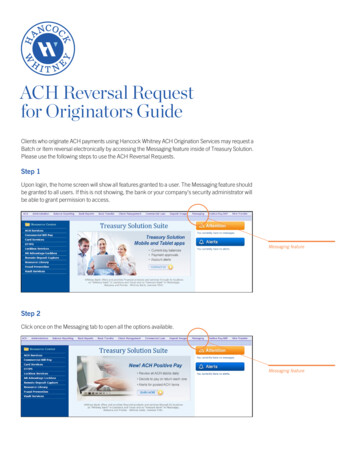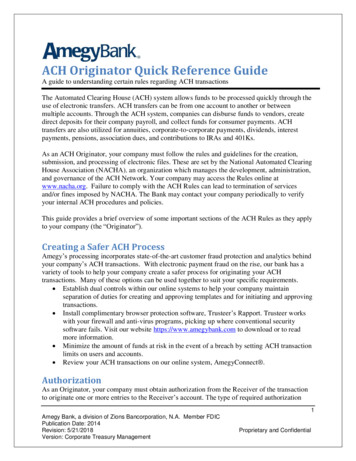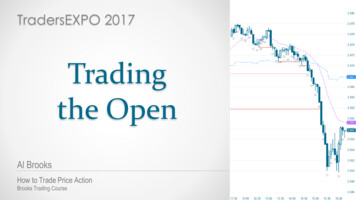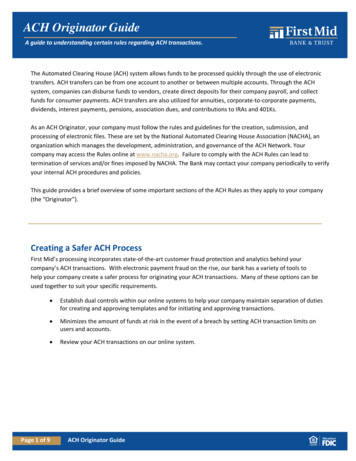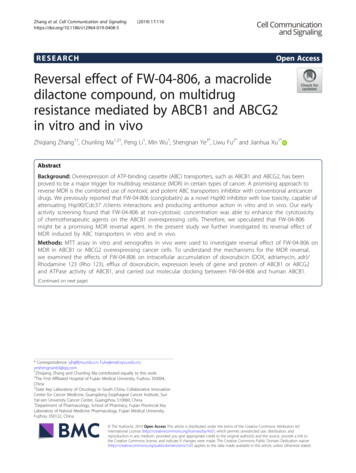
Transcription
Zhang et al. Cell Communication and (2019) 17:110RESEARCHOpen AccessReversal effect of FW-04-806, a macrolidedilactone compound, on multidrugresistance mediated by ABCB1 and ABCG2in vitro and in vivoZhiqiang Zhang1†, Chunling Ma1,2†, Peng Li1, Min Wu1, Shengnan Ye3*, Liwu Fu2* and Jianhua Xu1*AbstractBackground: Overexpression of ATP-binding cassette (ABC) transporters, such as ABCB1 and ABCG2, has beenproved to be a major trigger for multidrug resistance (MDR) in certain types of cancer. A promising approach toreverse MDR is the combined use of nontoxic and potent ABC transporters inhibitor with conventional anticancerdrugs. We previously reported that FW-04-806 (conglobatin) as a novel Hsp90 inhibitor with low toxicity, capable ofattenuating Hsp90/Cdc37 /clients interactions and producing antitumor action in vitro and in vivo. Our earlyactivity screening found that FW-04-806 at non-cytotoxic concentration was able to enhance the cytotoxicityof chemotherapeutic agents on the ABCB1 overexpressing cells. Therefore, we speculated that FW-04-806might be a promising MDR reversal agent. In the present study we further investigated its reversal effect ofMDR induced by ABC transporters in vitro and in vivo.Methods: MTT assay in vitro and xenograftes in vivo were used to investigate reversal effect of FW-04-806 onMDR in ABCB1 or ABCG2 overexpressing cancer cells. To understand the mechanisms for the MDR reversal,we examined the effects of FW-04-806 on intracellular accumulation of doxorubicin (DOX, adriamycin, adr)/Rhodamine 123 (Rho 123), efflux of doxorubicin, expression levels of gene and protein of ABCB1 or ABCG2and ATPase activity of ABCB1, and carried out molecular docking between FW-04-806 and human ABCB1.(Continued on next page)* Correspondence: xjh@fjmu.edu.cn; ng Zhang and Chunling Ma contributed equally to this work.3The First Affiliated Hospital of Fujian Medical University, Fuzhou 350004,China2State Key Laboratory of Oncology in South China, Collaborative InnovationCenter for Cancer Medicine, Guangdong Esophageal Cancer Institute, SunYat-sen University Cancer Center, Guangzhou 510060, China1Department of Pharmacology, School of Pharmacy, Fujian Provincial KeyLaboratory of Natural Medicine Pharmacology, Fujian Medical University,Fuzhou 350122, China The Author(s). 2019 Open Access This article is distributed under the terms of the Creative Commons Attribution 4.0International License (http://creativecommons.org/licenses/by/4.0/), which permits unrestricted use, distribution, andreproduction in any medium, provided you give appropriate credit to the original author(s) and the source, provide a link tothe Creative Commons license, and indicate if changes were made. The Creative Commons Public Domain Dedication o/1.0/) applies to the data made available in this article, unless otherwise stated.
Zhang et al. Cell Communication and Signaling(2019) 17:110Page 2 of 16(Continued from previous page)Results: The results indicated that FW-04-806 significantly enhanced the cytotoxicity of substratechemotherapeutic agents on the ABCB1 or ABCG2 overexpressing cells in vitro and in vivo suggesting itsreversal MDR effects. FW-04-806 increased the intracellular accumulation of DOX or Rho123 by inhibiting theefflux function of ABC transporters in MDR cells rather than in their parental sensitive cells. However, unlikeother ABC transporter inhibitors, FW-04-806 had no effect on the ATPase activity nor on the expression ofABCB1 or ABCG2 on either mRNA or protein level. Molecular docking suggested that FW-04-806 may havelower affinity to the ATPase site, which was consistent with its no significant effect on the ATPase activity ofABCB1; However FW-04-806 may bind to substrate binding site in TMDs more stably than substrate anticancerdrugs therefore obstruct the anticancer drugs pumped out of the cell.Conclusions: FW-04-806 is a compound that has both anti-tumor and reversal MDR effects, and its antitumorclinical application is worth further study.Keywords: FW-04-806, ABCB1 transporter, ABCG2 transporter, Multiple drug resistance, Molecular dockingBackgroundChemotherapy is the main treatment for many malignant tumors. Multidrug resistance (MDR) in cancer cellsproduces cross-resistance towards a huge cluster ofstructurally and functionally unrelated chemotherapeuticdrugs and this significantly decreases the efficacy of cancer chemotherapy [1]. The most common mechanism ofMDR is the overexpression of ABC transporters, whichactively pump numerous chemotherapeutic drugs outfrom cancer cells, thereby attenuating the efficacy ofchemotherapeutic agents [2]. Currently, 49 members ofthe ABC transporter family have been identified and aredivided into seven subfamilies (from ABCA to ABCG)based on the sequence and structure similarities [3, 4].The subfamily ABCB1/MDR1/P-glycoprotein, ABCC1/MRP1, and ABCG2/BCRP play a major role in producing MDR in tumor cells [5]. ABCB1 (MDR1/P-gp) wasthe first eukaryotic ABC transporter identified that confers MDR in cancer cells [6]. ABCB1, is a 170 kDa membrane-associated glycoprotein, is composed of twohomologous halves, each containing six transmembranedomains and an ATP binding domain, separated by aflexible polypeptide linker [7]. It can transport a widerange of antineoplastic drugs such as the anthracyclines,vinca alkaloids, taxanes, and epipodophyllotoxins [8].ABCG2 is known as a half transporter that effluxesagents with amphiphilic characteristics [9, 10]. It canactively efflux a wide variety of antineoplastic drugsincluding mitoxantrone, topoisomerase I inhibitors andanthracyclines, as well as fluorescent dyes such asHoechst 33342 [11]. ABCC1 is a 190-kDa protein thatwas first discovered in DOX resistant HL60/adr andH69AR cell lines [12, 13]. Its substrates include vinblastine (VLB), vincristine (VCR) and so on.Since the discovery of ABC transporter inhibitor, combined use of the inhibitor with conventional anticancerdrugs may represent a promising strategy to circumventMDR [14]. To date, three generations of MDR inhibitorshave been developed, some of which are currently underclinical trials to evaluate their usefulness in circumventing anticancer drug resistance [2]. However, many ofthese inhibitors failed to be utilized in clinical application due to the unacceptable toxicity as well as problematic pharmacokinetic interactions [15]. Screening ofMDR reversers will provide new sources for researchand development of new MDR reversal agents.FW-04-806, a macrolide dilactone compound withdouble-oxazole ring, was isolated from the fermentationproduct of the China-native Streptomyces FIM-04-806,and was identified to be conglobatin [16, 17]. We previously reported that FW-04-806 was a Hsp90 inhibitorwith low toxicity, and protein binding experiments andimmunoprecipitation had shown that FW-04-806 couldinterfere with Hsp90 and Cdc37 binding, mediate thedegradation of a series of Hsp90 client proteins and produce antitumor action in vitro and in vivo [18]. Basedon the early activity screening, we found that FW-04806 at a non-cytotoxic concentrations could enhance thecytotoxicity of chemotherapeutic agents on the ABCB1overexpressing cells in vitro. Therefore, we speculatethat FW-04-806 may be a promising MDR reversalagent. This work was intended to investgate FW-04-806on reversing MDR mediated by ABCB1 or ABCG2 andits mechenism.Materials and methodsChemicals and reagentsDoxorubicin (DOX), paclitaxel, vincristine (VCR), cisplatin, topotecan, mitoxantrone (MX), verapamil (VRP),KO134, rhodamine123 (Rho123), 3-(4, 5-dimethylthiazol-2-yl)-2, 5-diphenyltetrazolium bromide (MTT)and dimethyl sulfoxide (DMSO) were all purchased fromSigma-Aldrich (St. Louis, MO, USA). SYBR GreenqPCR Master Mix was purchased from TaKaRa.
Zhang et al. Cell Communication and Signaling(2019) 17:110Dulbecco’s modified Eagle medium (DMEM) and RPMI1640 were obtained from Gibco BRL (Thermo Fisher Scientific Inc., Waltham, MA, USA). Monoclonal antibodiesagainst ABCB1, ABCG2, glyceraldehyd-3-phosphate dehydrogenase (GAPDH) were from Santa Cruz Biotechnology (Santa Cruz, CA, USA). FW-04-806 with a purity ofmore than 98% was obtained from Institute of MateriaMedica, Fujian Medical University (Fuzhou, China).Cell linesKB (human oral epidermoid carcinoma cell line) and itsvincristine-selected ABCB1 overexpressing cell lineKBv200 [19], K562 (human chronic myelogenousleukemia cell line) and its doxorubicin selected ABCB1overexpressing cell line K562/adr were cultured in RPMI1640 medium supplemented with 10% FBS in the presence of 5% CO2 at 37 C. MCF-7 (human breast carcinoma cell line) and its doxorubicin selected ABCB1overexpressing cell line MCF-7/adr [20], S1 (humancolon carcinoma cell line) and its mitoxantrone-selectedABCG2-overexpressing cell line S1-M1-80 [21], H460(human non-small cell lung cancer cell line) and its MXselected ABCG2-overexpressing cell line H460/MX20,HEK293 (human embryonic kidney cell line) and itsempty vector or ABCB1, ABCG2 expressing vectorstable transfecting cell lines HEK293/pcDNA3.1,HEK293/ABCB1, HEK293/ABCG2-R2 [22] were cultured in DMEM medium supplemented with 10% FBS inthe presence of 5% CO2 at 37 C. The above commercialcell lines were originally obtained from American typeculture collection (ATCC). HEK293 and its transfectedcell lines were kind gift provided by Dr. Susan Bates(National Cancer Institute, NIH, Bethesda, MD, U.S.A).The transfected cells were cultured in DMEM mediumcontaining 2 mg/mL G418. All cells were grown in drugfree culture medium for more than 2 weeks before assay.Cell cytotoxicity assayMTT assay was used to tests cell cytotoxicity and a drugconcentration required to inhibit cell growth by 50%(IC50) was used to measure the sensitivity of cell to chemotherapeutic agents as described previously [23].Briefly, cells growing in logarithmic phase were seededat a density of 2000 7000 cells per well in 96-well plates.When the cells became adherent 24 h later, a range ofdifferent concentrations of conventional chemotherapeutic drugs with or without a fixed combination of FW-04806 were added to the wells. After 72 h incubation,MTT (5 mg/mL, 20 μL) was added into each well, and 4h later, the medium was discarded and 150 μL DMSOwas added into the wells to dissolve the formazan product from the metabolism of MTT. Finally, optical densitywas measured at 540 nm by a Model 550 MicroplateReader (Bio-Rad, Hercules, CA, USA). IC50 wasPage 3 of 16calculated from survival curves using the Bliss method[24]. The fold of resistance MDR cells to a drug was calculated by dividing the IC50 of the drug for the MDRcells by that of the same drug for the parental sensitivecells. The reversal degree (fold reversal) of a reversalagent for MDR was calculated by dividing the IC50 of achemotherapeutic agent to MDR cells without a reversalagent by that of the chemotherapeutic agent with the reversal agent. All experiments were repeated at least threetimes.Animal experimentsKBv200 cell xenograft model was established as described previously [25]. Briefly, KBv200 cells at the logarithmic growth phase (2 107 /0.2 mL/mouse) wereinoculated into axillary subcutaneous of athymic nudemice (BALB/c-nu, male, 5 to 6 weeks of age, 18 to 22 gof weight, purchased from Shanghai SLAC LaboratoryAnimal Co. LTD.). When the tumor volume reached to5 5 mm3, the mice were randomized into four groupsby tumor size and received various treatments: (a) vehicle (gavage/p.o., q3d); (b) vincristine (0.5 mg/kg, tailvein injection/i.v., q3d); (c) FW-04-806 (100 mg/kg, gavage/p.o., q3d); (d) FW-04-806 (100 mg/kg, gavage/p.o.,q3d, given 1 h before injecting vincristine) plus vincristine (0.5 mg/kg, tail vein injection/i.v., q3d). The bodyweights of the animals, tumor’s long diameter (L) andshort diameter (W) were recorded every 3 days, andtumor volume (V) was estimated according to the following formula: V L W2/2. At the end of the observation period, the mice were euthanized and thexenografts were excised and weighed. The curves oftumor growth was drawn according to tumor volumeand days after treatment. The ratio of growth inhibition(IR) was calculated according to the following formula[25]:IR ð%Þ ¼ ð1-Mean tumor weight o f experimental groupÞ 100Mean tumor weight o f control groupThe animal experiment protocols were approved by animal care and use committee, Fujian Medical University,China.DOX and Rho 123 accumulation assayFlow cytometry assay was performed to measure theeffects of FW-04-806 on the intracellular accumulationof DOX or Rho 123 in cancer cells as previouslydescribed [19]. Briefly, cells were seeded in six wellplates overnight and were pretreated with different concentrations of FW-04-806 or vehicle at 37 C for 3 h;DOX (10 μM) or Rho 123 (5 μg/mL) was added to themedium for further incubation for another 3 h or 0.5 hrespectively, then the cells were collected, centrifuged,and washed 3 times with chilled phosphate buffered
Zhang et al. Cell Communication and Signaling(2019) 17:110saline (PBS). Finally, the cells were resuspended in500 μL PBS and analyzed by flow cytometry (CytomicsFC500, Beckman Coulter Inc., Brea, CA, USA). Verapamil,a known ABCB1 inhibitor, was used as a positive controlfor ABCB1- overexpressing cells [26]. KO134, a specificABCG2 inhibitor, was used as a positive control forABCG2-overexpressing cells [27].DOX efflux assayDOX efflux was performed as described earlier [28].KBv200 or S1-MI-80 cells were pre-treated with 10 μMDOX at 37 C for 3 h. The cells were washed three timeswith PBS and incubated with fresh culture media in thepresence or absence of 5 μM FW-04-806 for KBv200cells or 10 μM FW-04-806 for S1-MI-80 cells at 37 Cfor 0, 15, 30, 60 and 90 min respectively. Then, the cellswere collected at the different time points and washedthree times with ice-cold PBS. Finally, the cells were resuspended in ice-cold PBS buffer for flow cytometricanalysis immediately.ABCB1 ATPase activity assayABCB1 ATPase Activity Assay Kit (Promega, V3601)was used to evaluate the effect of FW-04-806 on ATPaseactivity of recombinant human ABCB1. We prepared aseries of concentrations of FW-04-806 solution to betested according to the manufacturer’s protocol.Western blot analysisWestern blot analysis was performed as previouslydescribed [29]. The cells were treated with a range ofdifferent concentrations of FW-04-806 and were collected at time points. The proteins were extracted andthe concentrations were determined using the BCA Protein Assay kit (Thermo Scientific). Equal amounts ofproteins were separated by SDS-PAGE and transferredto polyvinylidene difluoride membranes. After blockingwith 5% non-fat milk for 2 h at room temperature, themembranes were incubated with the indicated primaryantibodies overnight at 4 C. The membranes were thenwashed three times and incubated with horseradish peroxidase conjugated secondary antibody for 2 h at roomtemperature. After three washes, proteins were detectedusing the chemiluminescent detection reagents. GAPDHwas used as a loading control.Real-time quantitative PCRABCB1 and ABCG2 mRNA expression level was assayedas previously described [30]. After treatment of FW-04806, total cellular RNA was isolated by Trizol ReagentRNA extraction kit. The first strand cDNA was synthesized by cDNA reverse transcription kit (TaKaRa). Realtime quantitative PCR primers were 5′-CAGGCTTGCTGTAATTACCCA-3′(forward) and 5′-TCAAAGAAACPage 4 of 16AACGGTTCGG-3′(reverse) for ABCB1, 5′-TGGCTGTCATGGCTTCAGTA-3′(forward) and 5′-GCCACGTGATTCTTCCACAA-3′(reverse) for ABCG2, 5′GAGTCAAGGATTTGGTCGT-3′(forward) and 5′GATCTCGCTCCTGGAAGATG-3′(reverse)forGAPDH, respectively. SYBR Green Assay kit (TaKaRa)was used for real time PCR reaction, following manufacturer’s protocol. Relative quantification of ABCB1 orABCG2 was analyzed using the 2- Ct method as a ratiorelative to the GAPDH expression level in each sample,respectively.Docking analysisTo understand the possible interaction between FW-04806 and ABCB1, molecular docking study was carriedout. We used the molecular structure of human P-glycoprotein (PDB ID: 6C0V) provided by Y. Kim, which contains two cytoplasmic nucleotide binding domains(NBDs) and two transmembrane domains (TMDs) [31].The two NBDs together bind and hydrolyse ATP to provide a driving force for transport, while the TMDs areinvolved in substrate recognition and translocationacross the lipid membranes (Fig. 7a–b) [32]. Before performing ligand docking, Multi-Channel Surface Modewas adopted to search for the binding pocket and to generate the protomol of the P-glycoprotein [33]. Then the energy minimized structure of FW-04-806, Doxorubicin(DOX) and Paclitaxel (PTX) were subjected to SurflexDock program in SYBYL-X 2.0 version. The docking scoresare expressed in units of -lgKd to evaluate the dockingresults, where Kd represents a dissociation constant of aligand; The scores represent the affinity between the ligandand the P-glycoprotein [34].Statistical analysisResults were shown as mean SD. All experiments wererepeated at least three times, and the differences weredetermined by using the Student t test. The statisticalsignificance was determined to be “*” P 0.05 and “**”P 0.01.ResultsFW-04-806 enhanced the efficacy of substratechemotherapeutic agents in ABCB1 and ABCG2overexpressing cells in vitroThe structure of FW-04-806 is shown in Fig. 1a. To findout the suitable concentration of FW-04-806 for reversing MDR in vitro, we firstly examined the cytotoxiceffect of FW-04-806 on different cell lines by MTTassay. As shown in Fig. 1b h, the results showed thatthe IC50 values of FW-04-806 in ABCB1 overexpressingcell lines were all more than 13 μM and that in ABCG2overexpressing cell lines all more than 50 μM. Thus, wechose concentrations of 5 μmol/ L and 10 μmol/L FW-
Zhang et al. Cell Communication and Signaling(2019) 17:110Page 5 of 16Fig. 1 The structure of FW-04-806 and its cytotoxicity in drug resistant cell lines and their parental cell lines. The structure of FW-04-806 (a).Cytotoxicity of FW-04-806 on KBv200 and KB cells (b), S1-MI-80 and S1cells (c), K562/adr and K562 cells (d), H460/MX20 and H460 cells (e), MCF-7/adr and MCF-7 cells (f), HEK293/pcDNA3.1 and stable ABCG2 transfected HEK293/ABCG2-R2 cells (g) and HEK293/pcDNA3.1 and stable ABCB1transfected HEK293/ABCB1 cells (h). All cells were treated with different concentrations of FW-04-806 for 72 h. Data are expressed as mean SDfrom three independent experiments04-806 as the maximum concentration for further reversalassay in ABCB1 and ABCG2 overexpressing cell linesrespectively, at the chosen concentrations more than 80%of cells surviving. In addition, the IC50 values of FW-04806 in ABCB1 or ABCG2 overexpressing cell lines weremuch closer to that in their parental sensitive cells, andthe range of fold-resistance in MDR cell lines was from0.78 to 2.67 (Fig. 1b h), which similar to that of non-substrate drugs in the same MDR cell lines (from 0.5 to 5.8)(Table 2). These data suggested that FW-04-806 may be a
(2019) 17:110Zhang et al. Cell Communication and SignalingPage 6 of 16Table 1 MDR reversal effect of FW-04-806 on ABCBl or ABCG2 substrate drugsIC50 SD μM (fold-reversal)CompoundKBDoxorubicin0.0346 0.0061FoldresistanceKBv200(ABCB1)(1.00)2.9903 0.3484(1.00) 1.25 μM FW-04-8060.0360 0.0086(0.96)1.1805 0.3313(2.53) 2.5 μM FW-04-8060.0312 0.0045(1.11)0.5546 0.2563**(5.39)**** 5 μM FW-04-8060.0341 0.0197(1.01)0.4107 0.0603(7.28) 10 μM Verapamil0.0406 0.01140(0.85)0.4147 0.1578**(7.21)Vincristine0.0039 0.0001(1.00)4.4343 0.8370(1.00) 1.25 μM FW-04-8060.0046 0.0000(0.84)0.1236 0.0325**(35.87) 2.5 μM FW-04-8060.0039 0.0000(0.98)0.0518 0.0113**(85.64) 5 μM FW-04-8060.0030 0.0000(1.30)0.0156 0.0034**(284.86) 10 μM Verapamil0.0030 0.0002(1.31)0.0637 0.0122**(69.62)0.0023 0.0018(1.00)3.9227 2.3426(1.00)*Paclitaxel 1.25 μM FW-04-8060.0026 0.0006(0.90)0.1044 0.0474(37.59) 2.5 μM FW-04-8060.0028 0.0006(0.81)0.0457 0.0042*(85.80)* 5 μM FW-04-8060.0017 0.0001(1.38)0.0127 0.0038(308.55) 10 μM Verapamil0.0026 0.0003(0.88)0.0688 0.0394*(57.06)0.0382 0.0002(1.00)5.1410 1.8822(1.00) 1.25 μM FW-04-8060.0283 0.0006(1.35)5.8430 1.1266(0.88) 2.5 μM FW-04-8060.0307 0.0011(1.25)2.0657 0.9445(2.49)*K562Doxorubicin0.0372 0.0027(1.03)0.5321 0.0667(9.66) 10 μM Verapamil0.0402 0.0019(0.95)0.7843 0.1870*(6.55)0.0007 0.0000(1.00)0.1708 0.0051(1.00) 1.25 μM FW-04-8060.0007 0.0000(1.03)0.0368 0.0027**(4.65) 2.5 μM FW-04-8060.0006 0.0000(1.19)0.0193 0.0012**(8.84) 5 μM FW-04-8060.0007 0.0000(1.09)0.0040 0.0001**(43.04) 10 μM Verapamil0.0006 0.0000(1.18)0.0027 0.0002**(64.21)0.0068 0.0002(1.00)0.6002 0.0175(1.00)Paclitaxel 1.25 μM FW-04-8060.0072 0.0001(0.94)0.1401 0.0014(4.28) 2.5 μM FW-04-8060.0066 0.0002(1.02)0.0707 0.0011**(8.49)**** 5 μM FW-04-8060.0060 0.0001(1.12)0.0253 0.0013(23.76) 10 μM Verapamil0.0072 0.0001(0.93)0.0335 0.0004**(17.92)(1.00)8.9867 0.8227MCF-7Doxorubicin0.1653 0.0066(1.00)0.2010 0.0397(0.82)2.0513 0.1232(4.38) 2.5 μM FW-04-8060.1870 0.0608(0.88)0.8483 0.0740**(10.59) 5 μM FW-04-8060.2215 0.0486(0.75)0.4863 0.0086**(18.48) 10 μM Verapamil0.1769 0.0051(0.93)0.3688 0.0460**(24.37)(1.00)1.7513 0.0875HEK293/pcDNA3.10.0836 0.00011705.5134.6244.088.3MCF-7/adr (ABCB1) 1.25 μM FW-04-806Doxorubicin1335.9K562/adr (ABCB1) 5 μM FW-04-806Vincristine86.4**54.4HEK293/ABCB1(1.00) 2.5 μM FW-04-8060.0794 0.0017(1.05)0.2881 0.0077(6.08) 5 μM FW-04-8060.0726 0.0005(1.15)0.1479 0.0036**(11.84) 10 μM FW-04-8060.0879 0.0004(0.95)0.1467 0.0055**(11.94) 10 μM Verapamil0.0681 0.0005(1.23)0.1868 0.0002**(9.37)**20.9
(2019) 17:110Zhang et al. Cell Communication and SignalingPage 7 of 16Table 1 MDR reversal effect of FW-04-806 on ABCBl or ABCG2 substrate drugs (Continued)IC50 SD μM S1S1-MI-80(ABCG2)Foldresistance0.0409 0.0007(1.00)48.7067 5.6101(1.00) 2.5 μM FW-04-8060.0426 0.0008(0.96)23.2267 1.9806**(2.10) 5 μM FW-04-8060.0446 0.0019(0.92)20.3067 2.7537**(2.40) 10 μM FW-04-8060.0410 0.0017(1.00)17.2100 0.4694**(2.83) 2.5 μM KO134**0.0483 0.0075(0.85)0.3390 0.0134(143.66)0.6221 0.0639(1.00)168.1667 18.0736(1.00) 2.5 μM FW-04-8060.5729 0.1353(1.09)138.7333 3.2716(1.21) 5 μM FW-04-8060.4887 0.0452(1.27)116.6667 4.5170**(1.44)Topotecan 10 μM FW-04-8060.5137 0.0071(1.21)59.9400 7.3335(2.81) 2.5 μM KO1340.6414 0.0178(0.97)11.7120 2.9969**(14.36)(1.00)1.0716 0.0644H460Mitoxantrone0.0110 0.0001**(1.00)0.0109 0.0003(1.01)0.3994 0.0127(2.68) 5 μM FW-04-8060.0115 0.0005(0.96)0.2630 0.0097**(4.08)**** 10 μM FW-04-8060.0109 0.0002(1.01)0.2254 0.0057(4.75) 2.5 μM KO1340.0114 0.0006(0.97)0.1728 0.0015**(6.20)0.0583 0.0001(1.00)100.5367 9.0013(1.00) 2.5 μM FW-04-8060.0591 0.0015(0.99)66.9167 1.1787**(1.50) 5 μM FW-04-8060.0582 0.0002(1.00)53.4433 7.4395**(1.88) 10 μM FW-04-8060.0546 0.0004(1.07)38.3900 3.9674**(2.62)(1.02)**(4.77) 2.5 μM KO1340.0568 0.0003HEK293/pcDNA3.1Mitoxantrone21.0567 1.32380.0054 0.0006(1.00)0.4322 0.0139(1.00)0.0035 0.0000(1.55)0.2084 0.0275**(2.07) 2.5 μM FW-04-8060.0059 0.0001(0.91)0.1960 0.0102**(2.20) 5 μM FW-04-8060.0034 0.0001(1.59)0.1702 0.0291**(2.54)(1.11)**(1.45)0.0048 0.000197.41724.5HEK293/ABCG2-R2 1.25 μM FW-04-806 2.5 μM KO134270.3H460/MX20(ABCG2) 2.5 μM FW-04-806Topotecan1190.90.2990 0.000980.0Note: MTT assay was performed to analyze the cell survival after treatment with anticancer agents in the absence or presence of FW-04-806; VRP (specific inhibitorof ABCB1) and KO134 (a specific inhibitor of ABCG2) were used as the positive control. The fold reversal of MDR (values given in parentheses) was calculated bydividing the IC50 value for cells with the anticancer drug in the absence of FW-04-806 by that obtained in the presence of FW-04-806. Data was shown as mean SD from three independent experiments. *, P 0.05; **, P 0.01non-substrate drug of ABC transporters. Then we investigated reversal effect of FW-04-806 on MDR in ABCB1 orABCG2 overexpressing cancer cells. As expected, the IC50of substrate chemotherapeutic agents such as doxorubicin,vincristine, paclitaxel, mitoxantrone, topotecan in ABCB1or ABCG2 overexpressing cell lines were higher than inthe corresponding parental sensitive cell lines, and therange of fold resistance was from 20.9 to 1705.5 whichsuggested that ABCB1 or ABCG2 overexpressing cellswere extremely resistant to substrate chemotherapeuticagents compared with their parental sensitive cells(Table 1). However, treatment with FW-04-806 significantly decreased the IC50 of the substratechemotherapeutic agents in resistant cell lines overexpressing ABCB1 or ABCG2, showed that FW-04-806 wasable to enhance the effects of the chemotherapeutic agentsfor MDR cells, which suggested its effects on reversalMDR, and the reversal effect was concentration dependence of FW-04-806. The range of the highest reversal foldin different MDR cell lines were from 7.28 to 308.55 andfrom 2.54 to 4.75 for overexpressing ABCB1 and ABCG2cells repectively; While the IC50 of the substrate chemotherapeutic agents showed no obvious change in the corresponding parental sensitive cells treated with FW-04806 (Table 1). Meanwhile, FW-04-806 did not decreasethe IC50 of cisplatin, which is not a substrate of ABCB1 or
Zhang et al. Cell Communication and Signaling(2019) 17:110Page 8 of 16Table 2 MDR reversal effect of FW-04-806 on ABCBl or ABCG2 non-substrate drugsIC50 SD μM (fold-reversal)CompoundKBCisplatin 1.25 μM FW-04-806FoldresistanceKBv200(ABCB1)3.8680 1.3483(1.00)5.4893 1.5035(1.00)2.0117 0.1632(1.92)5.5650 1.2172(0.99) 2.5 μM FW-04-8063.7403 0.5553(1.03)4.0650 0.4293(1.35) 5 μM FW-04-8062.2227 0.3665(1.74)7.6887 3.0405(0.71) 10 μM Verapamil1.8723 0.3514(2.07)5.4337 2.1716(1.01)K562CisplatinK562/adr (ABCB1)1.0181 0.2686(1.00)5.8687 0.7091(1.00) 1.25 μM FW-04-8061.0200 0.0362(1.00)7.1563 1.4092(0.82) 2.5 μM FW-04-8061.0510 0.1333(0.97)7.7360 0.5774(0.76) 5 μM FW-04-8061.1273 0.0605(0.90)6.4127 0.9883(0.92) 10 μM Verapamil0.8974 0.0791(1.13)6.0500 1.6236(0.97)15.0700 0.3928(1.00)18.0167 0.4153(1.00) 1.25 μM FW-04-80618.7367 0.1401(0.80)18.0933 1.0193(1.00) 2.5 μM FW-04-80613.7733 0.5398(1.09)18.9100 0.2905(0.95) 5 μM FW-04-80616.4433 0.4456(0.92)16.7633 0.0981(1.07) 10 μM Verapamil18.4767 1.1412(0.82)20.6867 0.9530(0.87)(1.00)8.6940 0.1404MCF-7Cisplatin6.8007 0.0765(1.00)5.7683 0.0093(1.18)9.2183 0.2919(0.94) 5 μM FW-04-8065.6213 0.0837(1.21)7.5417 0.2921(1.15) 10 μM FW-04-8065.1467 0.0979(1.32)7.7477 0.0916(1.12) 10 μM Verapamil5.2640 0.0900(1.29)7.3300 0.2154(1.19)S112.7233 0.5525(1.00)12.8800 0.0608(1.00)12.9067 0.4382(0.99)13.3100 0.6678(0.97) 5 μM FW-04-80615.1167 0.3386(0.84)17.8867 0.3785(0.72) 10 μM FW-04-80613.2400 0.1967(0.96)14.6533 0.4388(0.88) 2.5 μM KO13415.5033 0.1124(0.82)16.2633 0.2538(0.79)H4604.1593 0.06181.01H460/MX20(ABCG2)(1.00)15.9633 0.3653(1.00) 2.5 μM FW-04-8063.4410 0.3634(1.21)15.8067 0.5622(1.01) 5 μM FW-04-8063.2287 0.0302(1.29)17.2300 0.2685(0.93) 10 μM FW-04-8063.8967 0.0093(1.07)14.8167 0.2974(1.08) 2.5 μM KO1344.0677 0.1045(1.02)17.0767 1.3276(0.93)6.8007 0.0765(1.00)3.8733 0.1240(1.00) 1.25 μM FW-04-8066.1203 0.0740(1.11)3.5323 0.1928(1.10) 2.5 μM FW-04-8066.0470 0.0252(1.12)4.6223 CG2) 2.5 μM FW-04-806Cisplatin1.2HEK293/ABCB1 2.5 μM FW-04-806Cisplatin5.8MCF-7/adr R2 5 μM FW-04-8066.4633 0.2812(1.05)3.9990 0.0717(0.97) 2.5 μM KO1346.8980 0.2655(0.99)4.7723 0.4980(0.81)0.57Note: MTT assay was performed to analyze the cell survival after treatment with anticancer agents in the absence or presence of FW-04-806; VRP(specific inhibitor of ABCB1) and KO134 (specific inhibitor of ABCG2) were used as the positive control. The fold reversal of MDR (values given inparentheses) was calculated by dividing the IC50 value for cells with the anticancer drug in the absence of FW-04-806 by that obtained in thepresence of FW-04-806. Data was shown as mean SD from three independent experiments
Zhang et al. Cell Communication and Signaling(2019) 17:110ABCG2, in the ABCB1 or ABCG2 overexpressing MDRcells (Table 2). Since chemotherapeutic MDR results fromvarious mechanisms, in order to demonstrate that FW-04806 enhanced the efficacy of substrate chemotherapeuticagents in MDR cells was limited to ABCB1- and ABCG2overexpressing cells, ABCB1 transfected HEK293/ABCB1cells or ABCG2-R2 transfected HEK293/ABCG2-R2 cellswere used to study the reversal MDR of FW-04-806. Asanticipated, FW-04-806 had reversal effects of ABCB1orABCG2 mediated resistance to paclitaxel, doxorubicin andvincristine in HEK293/ABCB1 cells or HEK293/ABCG2cells rather than the corresponding parental cell lines, andthe reversal effects were also concentration dependence(Table 1). The results suggested that FW-04-806 potentiated the sensitivity of ABCB1 and ABCG2 overexpressingcells to substrate chemotherapeutic agents such as DOX,VCR, paclitaxel, mitoxantrone and topotecan in vitro.Taken together, FW-04-806 was able to reverse MDR ofABCB1 or ABCG2 overexpressing cells to substrate chemotherapeutic agents, instead of non-substrate agents.Page 9 of 16FW-04-806 enhanced the anticancer effect of vincristinein ABCB1 overexpressing KBv200 cell xenografts model invivoTo investigate whether FW-04-806 could reverseABCB1-mediated MDR in vivo, we established theABCB1 overexpressing multidrug-resistant KBv200 cellxenogra
Reversal effect of FW-04-806, a macrolide dilactone compound, on multidrug . Conclusions: FW-04-806 is a compound that has both anti-tumor and reversal MDR effects, and its antitumor clinical application is worth further study. Keywords: FW-04-806, ABCB1 transporter, ABCG2 transporter, Multiple drug resistance, Molecular docking .
